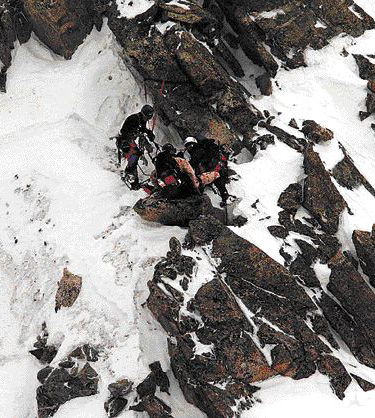Crash that transfixed nation
left no trace in Air Force data
It was ruled a crime,
not an accident

|
Dayton Daily News America watched as the Air Force searched a snow-covered mountain in Colorado for a $6 million A-10 jet that mysteriously crashed with a load of bombs in 1997.
The missing pilot, Capt. Craig D. Button, was the subject of morning network news shows, countless newspaper articles and lengthy military investigative reports.
 ASSOCIATED PRESS
AN AIR FORCE RESCUE team searches for Capt. Craig D. Button near the wreckage of his jet on 13,000-foot Gold Dust Peak in Colorado. The Air Force said the accident wasn't included in its statistics because Button committed suicide.
ASSOCIATED PRESS
AN AIR FORCE RESCUE team searches for Capt. Craig D. Button near the wreckage of his jet on 13,000-foot Gold Dust Peak in Colorado. The Air Force said the accident wasn't included in its statistics because Button committed suicide. |
The Air Force said the accident wasn't counted because Button committed suicide, making what happened to his plane a crime and not an accident.
The civilian National Transportation Safety Board includes suicides in its database and identifies the deaths in official fatality statistics, an NTSB spokesman said. The NTSB omits suicides from its accident rate &-- accidents per 100,000 flight hours &-- if an NTSB investigation concludes suicides were the cause of the crash, the spokesman said.
Without Button's crash on official records, the Air Force called 1997 "a relatively good year for the A-10 community" in its Flying Safety magazine. But even without counting the Button crash, there were three Class A accidents involving A-10s that year, one more than the previous year and exceeding the five-year average, according to the military's calculations.
Had the Air Force counted Button's crash, the number of Class A accidents for A-10s would have doubled the previous year's total. His accident also would have given Davis Monthan Air Force Base, Ariz., two major accidents in a single year, equaling the total number of major accidents the base recorded in the previous six years.
An Air Force instruction allows commanders to exclude suicides from accident rates.

|
In the Button case, the Air Force decided early on not to do its secret safety investigation. Instead, it dispatched a team of officers to do a publicly releasable and less thorough report called the Accident Investigation Report.
The officers &-- none identified as a criminal investigator &-- arrived at their conclusion that Button committed suicide not because they had physical evidence showing he had killed himself, but because they found no evidence that anything else could have happened.
Among several possible other explanations investigators were not able to rule out was alcohol or drug use. There weren't enough remains to test.
"I don't know what I would have ruled," said Eagle County Coroner Donna Barnes. "To some extent, it is still undetermined. We can still change what happened (the official cause of death) in the future."
Barnes, however, said some of Button's actions before the crash might have pointed to suicide.
"On every suicide, I'm not 100 percent convinced," she said.
The Air Force Office of Special Investigations interviewed numerous friends of Button's and produced a psychological autopsy report of more than 150 pages, which included some Bible passages Button was curious about.
"It appears deceased may have been thinking about this (suicide) for a long time," investigators wrote. For proof, investigators noted that Button once told a friend that he "wanted to run as far and as fast as I can" when he was troubled by a problem he couldn't solve.
Investigators also noted that Button, an avid skier, once wrote: "Nothing can compare with the thrill of flying down the snow-capped ridges of Colorado."
Even Gen. Richard E. Hawley, who headed the Air Combat Command at the time of the crash, wasn't convinced of what really happened.
"There is insufficient clear and convincing evidence to determine with certainty why this skilled pilot and fine officer departed formation flight and flew his aircraft to Colorado," says an addendum to the accident report written by Hawley, who retired in July. "There also is insufficient evidence to rule out, totally, some presently unknown medical explanation for his actions."
In absence of other evidence, Hawley wrote, suicide was the "most likely" cause.
Button's father, Richard Button, who served at Wright-Patterson Air Force Base in the late 1960s, disputes the finding and says the Air Force didn't recover enough wreckage to rule out some other cause, such as oxygen contamination or toxic fumes in the cockpit.
"You see the Air Force people never came up with any speculation of what could have happened," he said. "They didn't have any justification for that finding (suicide).
Official statistics mask actual number of crashes
Even deadly accidents may not be counted
Sidebars to Part 4:
ANATOMY OF A CRASH - PART 4
Witnesses watch flight's plunge
Both of the men in the A-6E Intruder were respected, experienced aviatorsCrash that transfixed nation left no trace in Air Force data
It was ruled a crime, not an accident